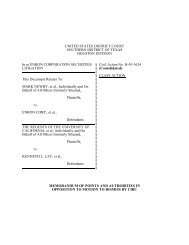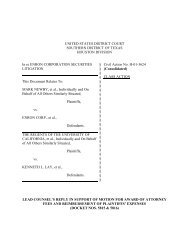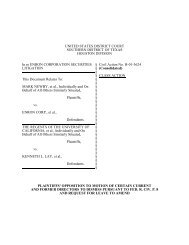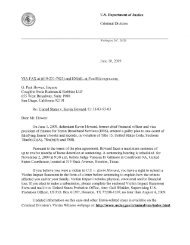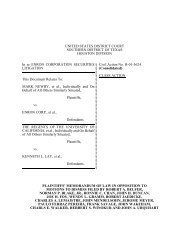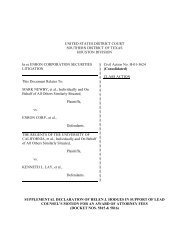Declaration Of Helen J. Hodges In Support Of Lead Counsel's ...
Declaration Of Helen J. Hodges In Support Of Lead Counsel's ...
Declaration Of Helen J. Hodges In Support Of Lead Counsel's ...
Create successful ePaper yourself
Turn your PDF publications into a flip-book with our unique Google optimized e-Paper software.
pricing or trade volume data, estimating damages is very problematic. We pressed our consultants to<br />
scour every available source for information about the long list of securities. Using the information<br />
that was gathered, our consultants estimated damages for as many securities as possible.<br />
284. We also considered whether and how to increase the recovery for claimants with §11<br />
claims. We recognized that the named plaintiffs and those they represented with §11 claims<br />
arguably should receive a higher percentage of loss as compared to those with only §10(b) claims.<br />
The reason for this is that a plaintiff need not prove reliance or scienter in order to prevail on a §11<br />
claim, in contrast to a §10(b) claim. We also took into account that on the facts of this case, because<br />
the fraud was so pervasive and, in our view, the defendants knew very well they were falsifying<br />
Enron’s reported financial condition, scienter would not be exceptionally difficult to prove and thus<br />
the added “burden” of the §10(b) fraud claim was not that great. We also considered that plaintiffs<br />
had initially alleged that all defendants in Newby violated §10(b) and when certain banks settled,<br />
they insisted on receiving a release of both §11 and §10(b) claims. Given all these considerations,<br />
we concluded that it was appropriate to increase the §11 claimants’ percentage recovery as compared<br />
to §10(b) claimants’. We asked Stanford Consulting to estimate a “multiplier” for the §11 claims.<br />
We discussed various assumptions for those estimates. We reviewed numerous versions of these<br />
estimates using various assumptions.<br />
285. After many discussions amongst ourselves and with Stanford Consulting, we had an<br />
overview of how to do the plan of allocation. Then we had to put our ideas on paper. Over the<br />
course of the summer of 2007 we reviewed countless drafts of the plan of allocation. We met with<br />
Chris Patti, Bob Fairbank, Rock Hankin and Stanford Consulting to discuss a draft in June. We also<br />
met several times with Stanford Consulting and Roman Weil, who has prepared a declaration<br />
supporting the plan of allocation.<br />
- 155 -



